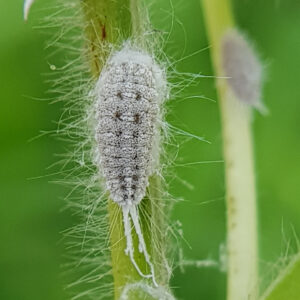The striped mealybug (Ferrisia virgata) is a pest of a broad range of plants. The two dark dorsal stripes that run longitudinally along its body, visible through bare patches on the waxy covering gave it its name. Additional identifying features are two posterior waxy tails, half the length of the body and the presence of hair-like crystalline hairs extending laterally from the body. The length of an adult female is about 2.0 to 4.5mm. The striped mealybug does not produce ovisacs, instead it constructs “pads” of waxy filaments in which eggs are deposited.
DAMAGE
A high population of mealybugs can lead to: fruit drop, fruit deformation and development of discolored welts on the rind of the fruit.
Mealybug secrete copious quantities of honeydew which is a substrate for a group of fungi, sooty mold. Sooty mold is black in color and may stain the fruit decreasing their market value as well as causing a delay in fruit color development. Photosynthetic potential, especially of young trees, may be negatively affected if sooty mold infection is severe. Ferrisia virgata is known to vector plant pathogens and has been reported to transmit Cocoa swollen shoot virus (CSSV), Citrus tristeza virus (CTV) and Piper yellow mottle virus (PYMoV). This mealybug is a phytosanitary pest in some export markets and if found on fruit destined for these markets, can result in rejection of the consignment and could place these markets at risk for the future.
There are specific natural enemies for different species of mealybugs.
For more information contact your local BioBee field agent.










